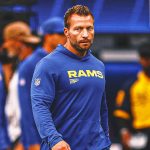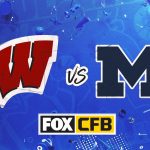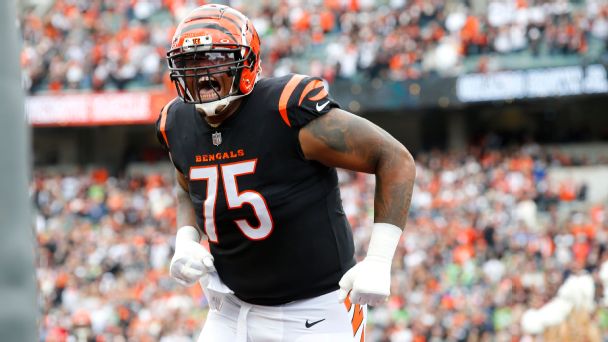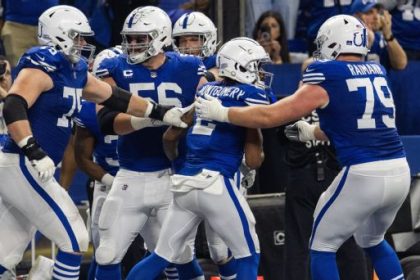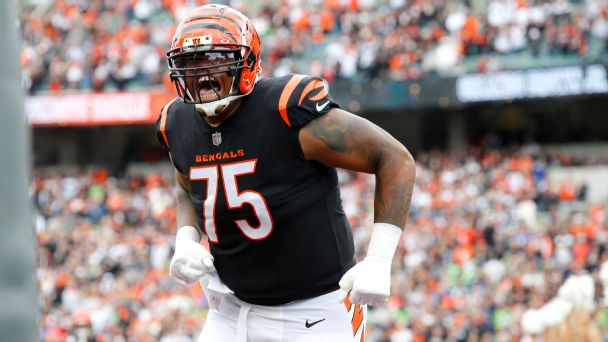
CINCINNATI — Cincinnati Bengals left tackle Orlando Brown Jr. was determined to make his mark.
So every Monday during Oklahoma’s intrasquad freshman scrimmage, Brown was going to fight someone. The person who was lined up against him was irrelevant. The important thing was he was going to start a scrap to get the coaches’ attention.
“I didn’t care who was over me, what the situation was, if it was a pass or a run — I was gonna start a fight somehow, some way,” Brown said. “And I was gonna be noticed through my physicality.”
That usually came at a price. Even when he was warned that he’d have to run as a punishment, he still started the fights. Because ultimately, Brown wanted to prove himself.
Nearly 10 years after his freshman season at Oklahoma, Brown is on that same mission. Even after four straight Pro Bowl appearances in his first five NFL seasons, the son of a long-time NFL tackle remains on a singular mission — to carve out his own legacy as one of the best.
Better than Anthony Muñoz, the Bengals legend and Hall of Famer. Better than Andrew Whitworth, a Super Bowl champion who played in the NFL for 16 seasons. Better than his dad.
“I want to lap them, you know?” Brown told ESPN. “And that’s to me, man, that’s what my motivation is — to go out there and be one of the greatest to do this.”
His next chance is Thursday night in a road game against the Baltimore Ravens (8:15 p.m. ET, Prime Video) with significant AFC North and playoff implications on the line.
The journey to prove that has taken him to the Bengals, his third team in six seasons. His two previous teams, the Baltimore Ravens and Kansas City Chiefs, decided to move on from Brown in favor of other players at his position or because the cost of his services was too steep.
That’s how he ended up in Cincinnati on a four-year, $64 million deal in the offseason, on an offensive line with four other starters who have had to prove themselves in the NFL as well.
He had a different upbringing than his father, Orlando Brown Sr., who grew up in a gritty part of Washington, D.C., and went from an undrafted free agent out of South Carolina State to a veteran NFL offensive lineman. And despite having a well-respected lineage, the younger Brown has had to show that he was worthy on his own merit.
Now in his sixth season, Brown is still looking to prove his status as one of the NFL’s best. That makes him a perfect fit on an offensive line, roster and organization that is yearning to show it is the best.
“That’s the culture of our organization,” Brown said. “It’s the culture of our team.
“It’s very motivating, man, especially in our room, to really go out there and be the who’s who of the NFL.”
BROWN WAS ON Cincinnati’s radar long before he became available in free agency.
Darrin Simons, the longtime special teams coordinator, was an assistant in Baltimore for a year when Orlando Brown Sr. played for the Ravens. Simmons recalled seeing the younger Brown, who was 2 years old at the time. And even back then, Simmons had a hunch that he would have similar size to the 6-foot-7, 360-pound man nicknamed “Zeus.”
“His dad is one of the biggest human beings I’ve ever seen in my life,” Simmons said. “And so I knew that he was going to be a monster whenever he grew up.”
In college, the elder Brown was a defensive lineman before he transitioned offensive tackle at South Carolina State, which plays in the Football Championship Subdivision. He went undrafted but was able to stick as an NFL right tackle for nearly a decade, even despite a three-year absence as he recovered from an eye injury after a referee’s penalty flag hit him. Simmons, whose uncle Jerry was Baltimore’s head strength coach, remembered hearing about how Brown was so stiff and immobile that the Ravens’ strength staff went through extraordinary measures to improve his flexibility.
“They used to physically tear his groin,” Simmons said. “Like, put him up against a wall and push down his legs so his groin and his hip girdle would tear to open things up and to make him more mobile.”
Brown instilled a work ethic in his son as he grew up, from making his son sweep the hair off the floors in Washington barber shops, to working in some of the Fatburger locations Brown owned.
“I never worked the cash register,” the younger Brown said. “I cleaned toilets, dishes, tables and floors.”
He didn’t play football until he was 13. When he started, he says he was really bad.
“I never met expectations in that area, in my opinion,” Brown told ESPN. “And so it was really hard mentally to be able to crawl out of this ditch that I had dug for myself that wasn’t even real.”
Brown started out at the prestigious DeMatha Catholic in the greater D.C. area. But after his father died in 2011 after diabetes complications, Brown moved to Georgia and was eventually a three-star recruit out of Peachtree Ridge, located roughly 30 miles northeast of Atlanta.
When he signed with Oklahoma, longtime Sooners assistant Bill Bedenbaugh said Brown wasn’t in shape to play college ball.
“I just remember times when I’m like, ‘Gosh, man, this guy can’t even run three plays in a row,'” Bedenbaugh told ESPN. “He’s dead tired. And he would try to push through and show his toughness.”
But Bedenbaugh saw, even as a redshirt freshman, Brown was going to work hard to be a good player for the Sooners. Brown started the next year and went on to start 40 games over the next three seasons.
“That’s why he has become a good player,” Bedenbaugh said. “Obviously, he’s self-motivated, but his dad was obviously one of the best O-linemen in the NFL. He had a lot to live up to. And I know that was always important to him.”
0:55
What’s at stake for Bengals, Ravens in Thursday night clash?
Marcus Spears previews the AFC North matchup between the Bengals and Ravens.
BROWN NOT ONLY developed into a reliable starter for Oklahoma but was one of the nation’s best offensive linemen. Under Bedenbaugh’s tutelage, Brown was a unanimous All-American by his final season and a finalist for the Outland Trophy, which goes to the nation’s top interior linemen.
Then came the NFL combine. He ran the 40-yard dash at 5.85 seconds and produced only 14 reps on the bench press. His stock plummeted and his father’s old team, the Ravens, took him in the third round of the 2018 draft.
When Baltimore made the pick, then-assistant general manager Eric DeCosta said the physicality he saw on tape outweighed Brown’s combine performance. And even though Brown was slow, general manager Ozzie Newsome appreciated the fact Brown was willing to test himself while other offensive linemen opted out of running.
“You have to give ‘Lil’ Zeus’ some credit for saying, ‘Hey, I’m going to go out here and compete and do as well as I can,'” Newsome said the night Brown was selected.
At the time, it was fitting. When Brown was in second grade, he was asked to write down what he wanted to do in 20 years — play left tackle for the Ravens. And he made his intention to play on the left side very clear as soon as he arrived.
“He told me that when he first got here,” said Ravens tackle Ronnie Stanley, who occupied that spot. “I wasn’t surprised at all. It is what it is. There was never any animosity.”
Brown wanted to play the position as a promise to his father. Eventually, Brown realized that dream would go unfulfilled in Baltimore. Stanley signed a five-year extension worth nearly $99 million in 2020, the year before Brown was eligible for a new deal.
Brown asked for a trade and Baltimore obliged, sending him to Kansas City. He was there for two seasons, helping the franchise win Super Bowl LVII, a playoff run that included a win over Cincinnati in the AFC title game.
But the Chiefs never tied themselves to Brown long term. They gave him a one-year franchise tag for the 2022 season and couldn’t agree on a deal with Brown in 2023. That opened the door for the Bengals to sign him.
Cincinnati, which has been trying to retool its offensive line since drafting quarterback Joe Burrow first overall in 2020, signed Brown to a four-year deal worth $64 million. The deal featured $31.1 million in guaranteed money, the most ever given to a player in franchise history until Burrow signed his extension that included $219.01 million guaranteed.
“We’re really excited to get him in here and have him play left tackle for us and win those championships that we’ve been pursuing these last couple of years,” coach Zac Taylor said at Brown’s introductory news conference in March. “That’s what he’s all about. He’s experienced that before.”
THE DIFFERENCE BETWEEN playing right and left tackle has always been clear in Brown’s mind. Growing up, he heard his father lament that he never got the recognition he deserved by not facing the caliber of edge rushers that left tackles historically face.
Playing left tackle in Cincinnati wasn’t the only part of the allure. He studied the Bengals’ scheme and liked all of the responsibilities Cincinnati asks of its left tackles. Brown, who says he’s a football history buff, saw how Green Bay Packers left tackle David Bakhtiari and Whitworth, the former Rams and Bengals tackle, were used in concepts run by Mike Shanahan’s coaching disciples.
In Cincinnati, Brown is asked to block edge rushers one-on-one in pass-blocking, shuffle across the line of scrimmage on run plays and displace defenders in the open field. Those are the types of plays that give him opportunities to show he’s a great left tackle. And it’s part of the reason why he said he wanted out of Baltimore.
“It was hard to leave,” said Brown, who said he’s grateful to the Ravens’ front office for his time there. “It was one of the easiest systems that I played in. Everything they asked me to do was very easily complemented to my body type, by play style, blocking down half the game, you know, pass protection here and there.”
The Bengals are a passing team with Burrow at quarterback. Cincinnati ended Week 10 with the second-highest rate of designed passing plays in the league, which puts a lot of strain on the offensive line.
And the effectiveness of the line — and Brown — remains up for fierce debate.
As a team, the Bengals are 30th in pass block win rate. But Brown, who was 18th in win rate as a tackle in 2022 with Kansas City, is 47th in 2023 with the Bengals.
That hasn’t stopped the praise from people inside the building, however.
“He’s as advertised,” Burrow said after the Bengals beat the San Francisco 49ers on Week 8. “He’s a great player. Big, strong, athletic. You saw it [against the 49ers] blocking some of the best edge rushers in the league.”
Even after the offensive line struggled in a Week 10 loss to the Houston Texans, offensive coordinator Brian Callahan said he had no complaints.
“We weren’t quite as good against Houston for whatever reason,” Callahan said. “But I think Orlando’s been a really steadying presence for us on the left side.”
But for someone who has been driven by ambition, from living up to the expectations of being a “junior” to cementing himself as one of the game’s best tackles, merely anchoring the left side of Cincinnati’s offensive line isn’t good enough.
Throughout the scouting process, NFL teams constantly asked him what motivated him. Along with winning, the respect of his peers mattered most. And whether it was working to be a starter at Oklahoma or sweeping up hair or cleaning toilets, he appreciates the work it takes to be considered great.
Said Brown: “Those are just the things that were taught to me at a young age that have always been a driving force for me about my legacy and what I leave behind.”
ESPN Baltimore Ravens reporter Jamison Hensley contributed to this story.

